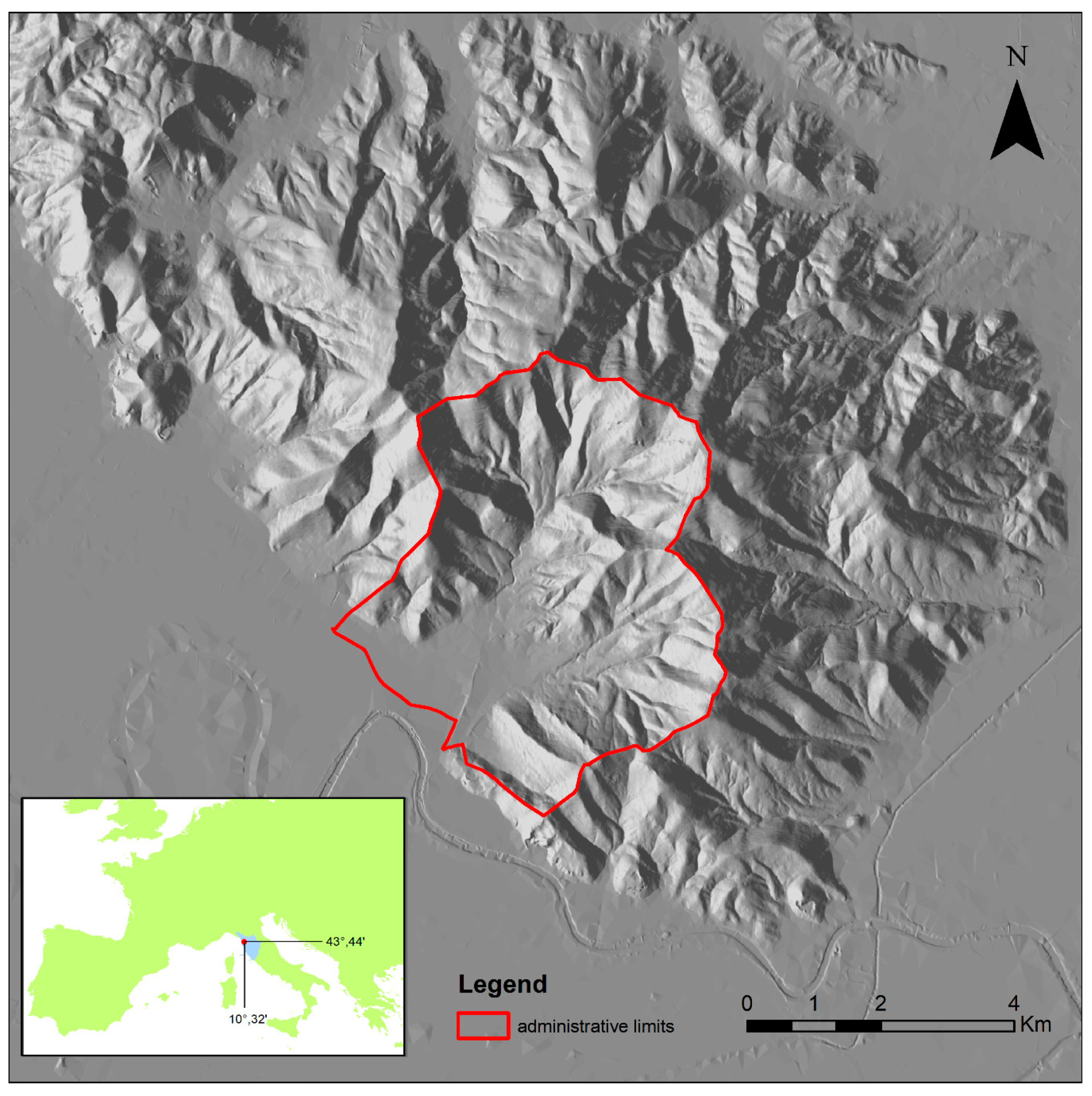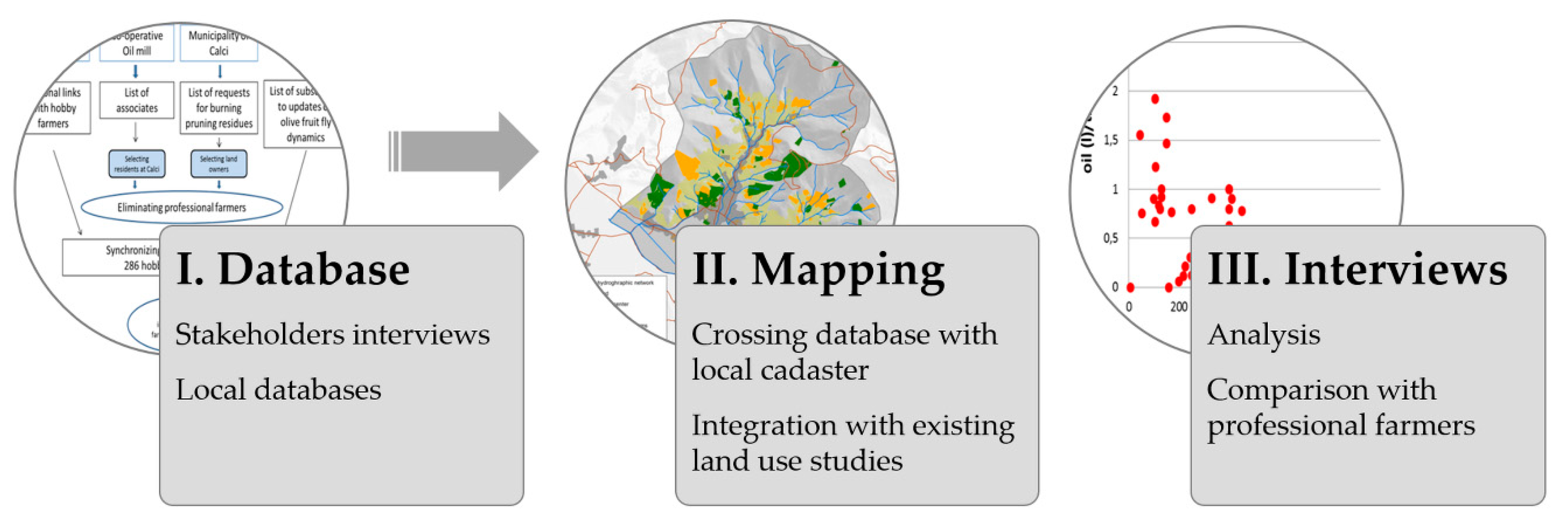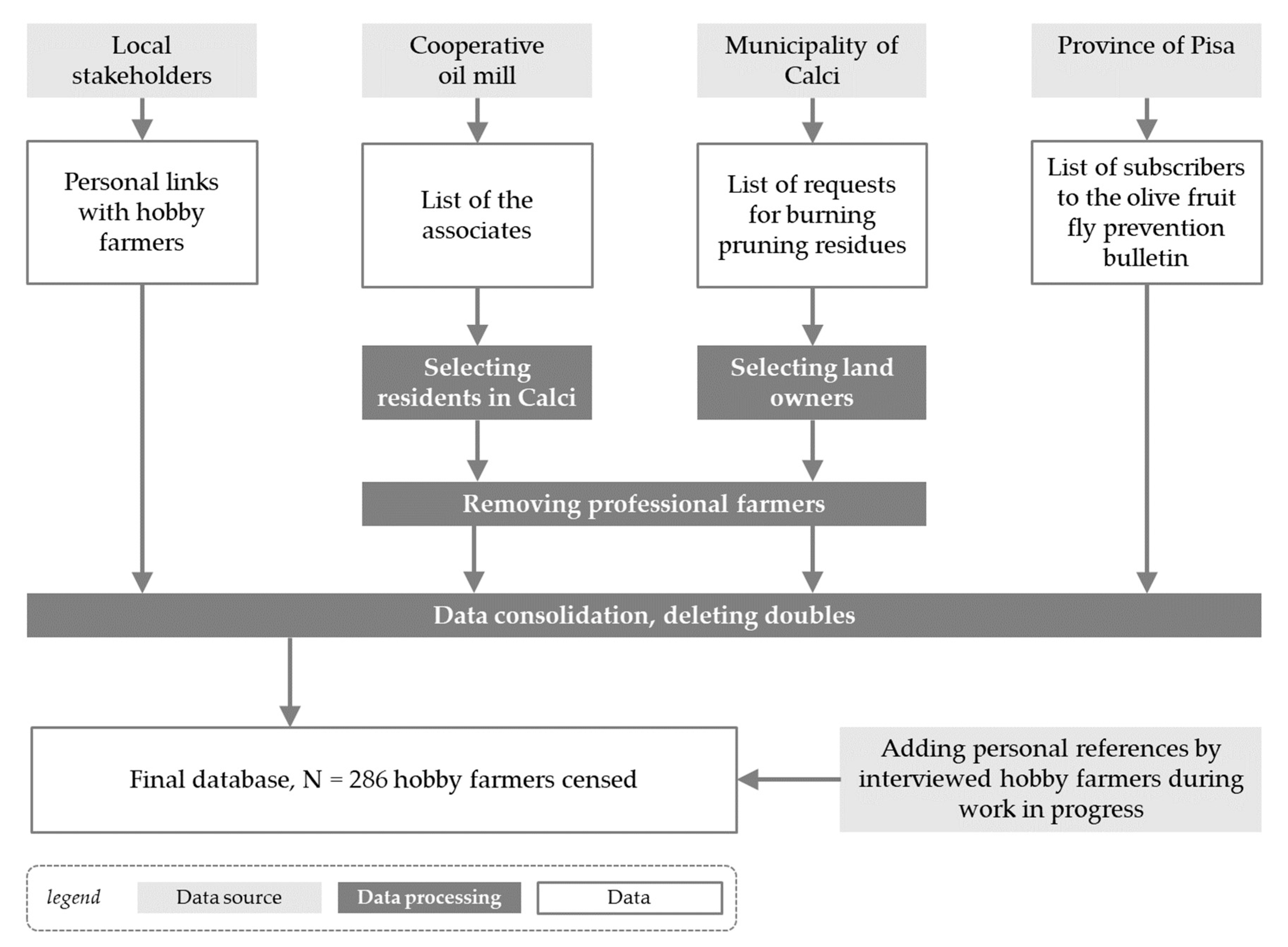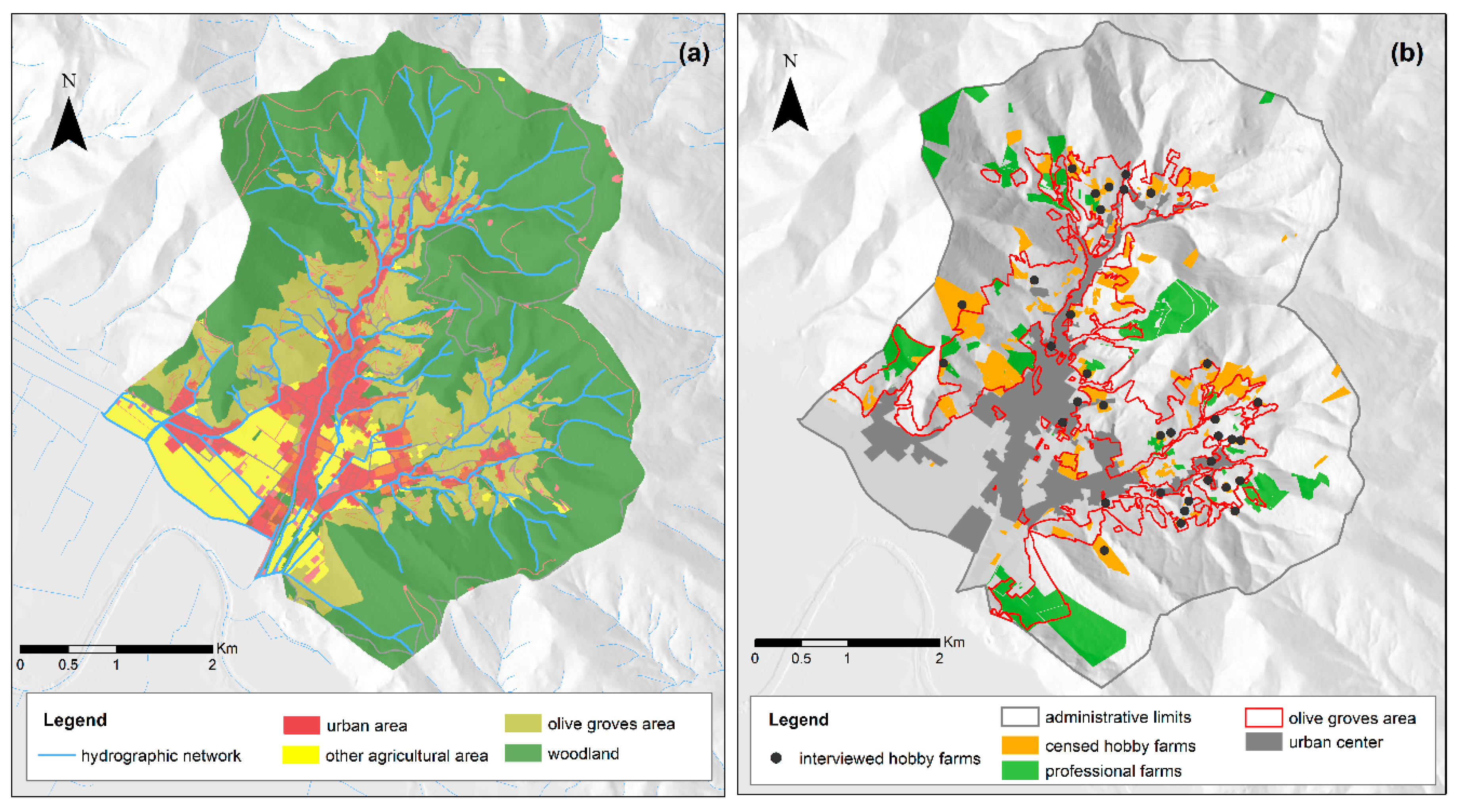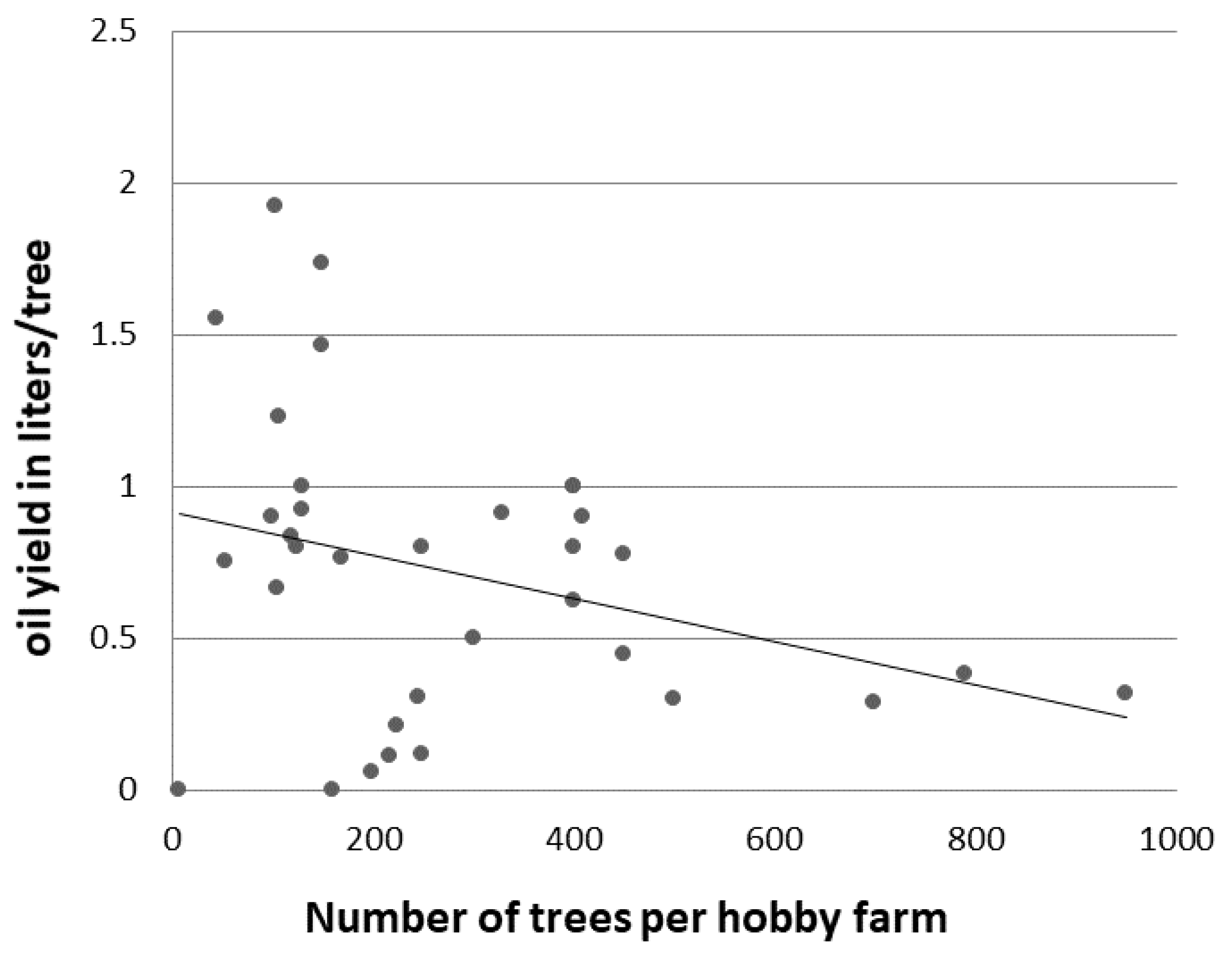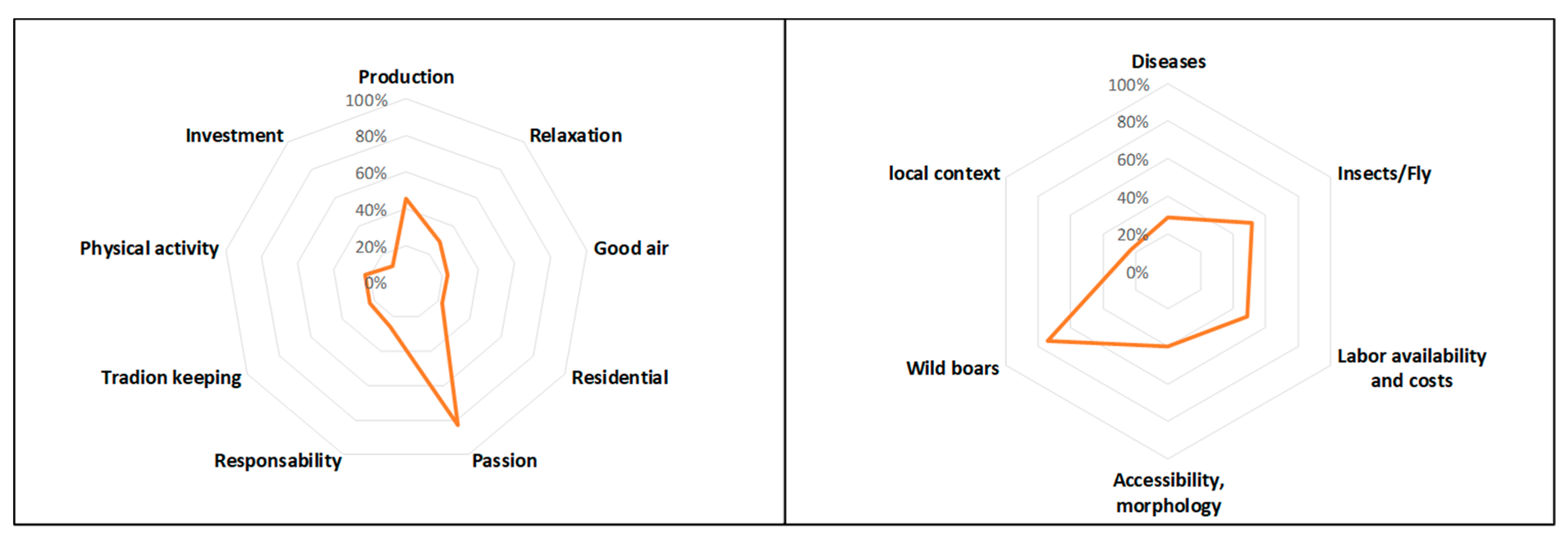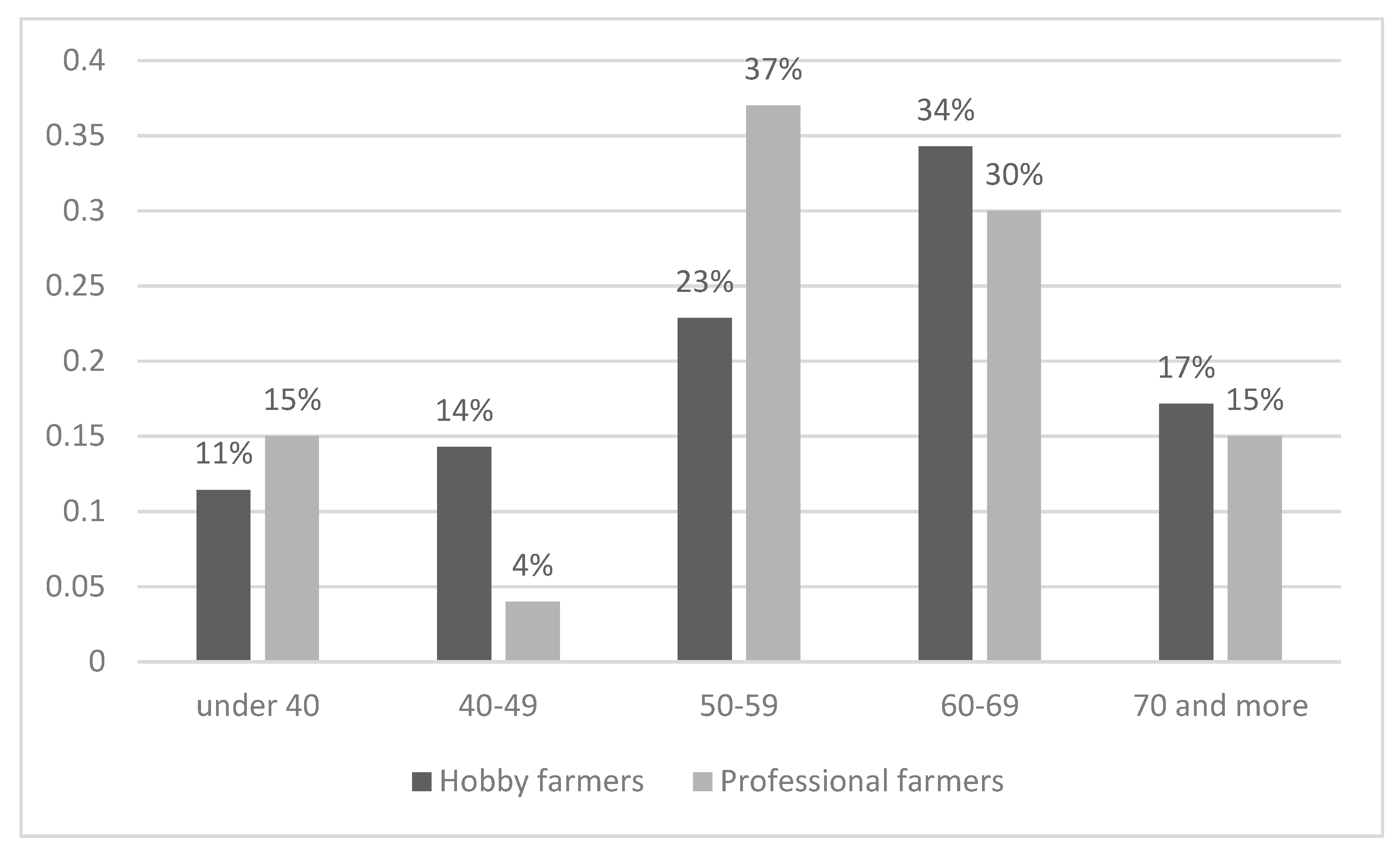1. Introduction
Agriculture in the Mediterranean has faced many changes in the last decades [
1]. Recent research focusing on Mediterranean land systems [
2,
3,
4] underlined the importance of permanent crops all over the Mediterranean basin, often associated with rangelands or annual crops. Among these permanent crops, olive groves are an important part of the Mediterranean agricultural economy [
5] and of the traditional Mediterranean cultural landscapes [
1,
6]. The olive tree is a symbol for the Mediterranean environments, and its distribution is often used to define the Mediterranean type of climate [
7]. Most of the olive groves in the Mediterranean are located in hilly and mountainous areas and have been described as Sloping and Mountainous Olive Production Systems or SMOPS [
8]. A part of these SMOPS are traditional groves placed on steep slopes with terraced grounds, which are a legacy of past human efforts to stabilize and exploit the sloping areas, though they have been gradually extensified or abandoned [
6]. The extensification and abandonment of traditional terraced olive groves, most often rain-fed, nonmechanized and having low productive cultivars and old implantations, was chiefly due to the lower or null profitability against more recent intensive olive plantations [
9]. These processes lead to different transitions in deep rural areas and in the areas under urban influence. In the latter, the proximity to urban centers eased a substitution of the former olive grove managers by new land managers such as urban dwellers or newcomers having in common a lack of agricultural origin or at least of professional interest in agriculture. The landscape has a great ideal value, and urban people are willing to pay for living in mostly city-near environments. A desired life context and the possibility to cultivate for family needs are drivers different from profitability for managing these landscapes [
10,
11,
12,
13,
14,
15]. Altogether, we refer here to hobby or lifestyle farmers to the various profiles who take over where professional farmers give up.
Professional farming has been studied so far across different land systems, especially for peri-urban areas as dynamic and changing environments [
16,
17,
18,
19]. Yet, only few studies addressed the hobby farmers. This may be related to the nonavailability of official statistic datasets, as these land managers are not registered as farmers, enterprises, producers, etc., and their economies and practices are largely unknown.
There is still a gap to be filled in the definition of hobby farmers. Hobby farming has been a research issue starting from the 1970s and 1980s of the last century, mostly in the Western hemisphere and Australia [
20,
21]. There has been a development mostly in city-near, peri-urban areas or well-connected areas. Some examples of transition from professional to part-time and hobby farming were documented in Southern Europe in Montado/Portugal for commuters to Lisbon [
22,
23] and in Valdera/Italy for commuters to Pisa or Florence [
24]. These land managers based their family income mainly on off-farm work.
Hobby farming is frequently associated in the literature with terms like small-scale farming, lifestyle farming, lifestyle landholding, amenity farming and noncommercial farming [
13,
20,
25,
26,
27,
28,
29]. In recent years—mostly in 2014 and 2015—the term “lifestyle farming” has been used more frequently than hobby farming. Nonetheless, we adopt here hobby farming, as it implicates more distinctly the difference from professional farming. All farming might have a lifestyle component, but hobby farming is something done in one’s spare time.
Our thesis is that hobby farmers contribute to what nowadays is mostly expected from agriculture by the European Union: land stewardship. In areas where production hardly can achieve economical sustainability, people who are fond of living in a rural environment take care of the landscape and consider themselves paid back by the possibility of growing their own vegetables, fruit or else safeguarding the food for the family and living in a healthy way in close contact to nature [
30]. Though, hobby farming is largely unrecognized by agricultural policy in Europe [
23]; thus, hobby farmers are most of the times excluded from traditional resources of state support, such as agroenvironmental funding. Hobby farmers have been studied for their motivations, as well as economic and social impacts, but less attention has been paid to their agricultural practices and, so, to their impact on the landscape.
The aim of this paper is to unravel hobby farming within an Italian traditional-terraced olive grove system and to characterize the farming and landscape practices of olive growers. The case study was located in the municipality of Calci. It is part of the Monte Pisano, in the peri-urban area of Pisa, Tuscany. Some research already addressed nonprofessional olive growers in this area [
31,
32,
33], but no study, to our knowledge, has dealt with the description of spatial distribution and characterization of these new land managers and of their farming practices. In addition, we compared hobby farmers with local professional olive growers to explore if their practices could result in different land use intensity. Our goals are to characterize at the local level a population of hobby farmers (“Who are they?”) and their contributions—in terms of main practices—to olive grove management (“What do they do?”), along with their motivations and difficulties, as well as potential for the land stewardship. In the end, we provide data for decision-makers at the local level to better understand the effects, problems and needs of the land managers of a common Mediterranean land system.
3. Results
The results of our study can be divided into two parts. First, the creation of the hobby farmers database (n = 286), then mapped to provide information about their spatial distributions. Second, the analysis of the survey on a sample of hobby farmers to highlight their characteristics and practices.
3.1. The Olive Groves in Calci Are Mainly Managed by Hobby Farmers
The olive grove surface in the municipality of Calci occupied 575.8 ha for the year 2014. The surface managed by the professional farms (99.1 ha) was mapped and detracted from the total olive grove surface, as well as the public-owned olive grove areas (6.2 ha). The remaining surface was owned by private people and managed or abandoned; only part of the 286 censed hobby farmers could be identified in the local cadaster (for instance, because the land property was frequently registered by relatives). The censed hobby farmers on who we had spatial information on the land properties (136 landowners) managed 84.5 ha of olive groves, having an average olive grove of 0.6 ha per person. The remaining 386 ha of the olive grove area could be attributed to be under management of not-surveyed hobby farmers—or abandoned (
Figure 4).
The 286 censed hobby farmers could be characterized in a whole only by gender. The hobby farmers were 70% male and 30% female, resulting from the given names. No further features were available for the whole sample. Age was known only in 33% of the hobby farmers: over 50% were of legal retirement age (over 65 years old), 34% between 65 and 40 and just four hobby farmers (4%) were less than 40 years old.
From the spatial analysis of the managed areas results, professional and hobby farms often also managed areas that had other land uses than olive groves mainly represented by forests in the upper part of the farmlands.
3.2. Characteristics of Hobby Farming in the Calci Municipality
A sample of 35 of the censed 286 hobby farmers was interviewed (12%), unravelling a picture of these land managers.
3.2.1. Sociodemographic Characteristics of the Sample
The sample was composed mainly by males (76%); only one out of four interviewees was a female (26%). The age structure of these farmers was normally distributed, with a peak on the age class of 60–69 years, which was consistent with the age distribution mentioned in the previous paragraph. The surveyed hobby farmers were mostly Italian, but 11% were other European citizens (UK, German or Austrian), a higher rate than those of foreign residents in the municipality (5%). Nearly half of the sample belonged to a two-people households. The average family was composed of two or three members (
Table 3).
Nearly 50% of the interviewed hobby farmers are retired from their jobs, so have much more spare time for their hobby. Another little group of hobby farmers that could have a lot of spare time is represented by the unemployed. This is a relatively new development: with the persistent economic crisis, people without a job try to make a living out of their land. The education level of Calci’s hobby farmers is high: 48% had a university degree. On the national scale, the hobby farmers with university degrees make out only 16%, while the biggest group (41%) are farmers with a high school degree [
42]. This high education level of the hobby farmers at Calci is presumably related to the characteristics of Pisa as important universities and a developed tertiary sector. The primary occupation of the employed hobby farmers ranged from professions in healthcare, public administration and specialized workers over artisans and freelance professionals to university professors.
3.2.2. Characteristics of the Hobby Farms
The origin of our sampled land managers is mostly by voluntary acquisition and not by heritage (
Table 4); however, most of them have managed the olive groves since more than 10 years ago. Three out of five of them lived outside the olive grove, in the nearby town or in a proximal peri-urban area.
The median size of the managed area per hobby farmer is of 0.50 ha, most properties being between 0.10 ha and 1.00 ha (
Table 5). For the management, the tree number is much more relevant for the labor input than the dimension of the olive grove, as tree density in this area ranges from 100 to 1081 trees per hectare. The number of trees managed by a single hobby farmer varies in our database. They manage each up to 450 trees, and just one hobby farmer manages a higher number of trees (750 trees). The average number of managed trees per hobby farmer is of 338.00 (1.19) trees and a median value of 224 trees. With the exception of three hobby farms, all are on terraced grounds, predominantly with traditional dry stone walls. Fifty-five percent of the hobby farmers have managed an olive grove for a long time, for more than 20 years, but there were a lot of “newcomers”, nearly a third of the sample, that have started only since a maximum of 10 years.
Three quarters of the interviewed hobby farmers harvest on all trees on their property (
Table 6). The production of olive oil varies between the single hobby farmers: ranging from 12.00 to 400.00 kg/year, with the median value of 150.00 kg/year (
Table 6). Olive cropping in Monte Pisano is hardly profit-providing, even for professional farms with at least 1000 trees. We examined the economic aspects of hobby farming: the input (expenses for fertilizers and treatments, machinery, fuel, oil mill, external labor (
Table 7 and
Table 8) and output (harvest and olive oil). Only eight hobby farmers declared to sell part of their olive oil (a percentage of 25% up to 80% of the single production). They produce between 100 and 400 kg (
Table 6).
The yield per tree varies from 0.11 to 1.92 L/tree, with a median of 0.78 L/tree. There can be various reasons for a very low yield—for example, any kinds of pests, low budgets of time and labor for the harvest, no interest in harvesting on all trees, etc.—but there appears to be a strong limitation for the maximum yield in correlation with the number of managed trees: 150 trees result in a maximum that is manageable efficiently with the harvest of all trees to achieve yields of close to 2 L per tree (
Figure 5). The next limit is on 450 trees: All hobby farmers with more than 450 trees are not able to have yields of over 0.5 L/tree. This may be explained by the harvesting on only part of the managed trees, as labor is not unlimitedly available, and external labor has a high cost.
The five hobby farmers that have the highest productivity (1.23 to 1.9 L/tree) per tree are all are male and manage olive groves of 1300 to 5000 m2 with 45–150 trees on an altitude of 80–210 m above sea level.
3.2.3. The Hobby Farmers’ Practices
The olive groves in the municipality of Calci are mainly composed by relatively old olive trees (over 50 years old), which have not been renewed in the last decades. Farming is essentially limited to the management of the trees and the soil, as well as some management of the surface water drainage (i.e., maintenance of the terraced system). In particular, annual practices are fertilization and pest control, the control of grassy undergrowth, pruning and the burning of pruning residues and harvesting. Olive cropping on terraced land is not suitable to mechanization, thus resulting as highly labor-demanding. The agricultural equipment is generally limited to handheld facilitators and shakers for the harvest, as well as brush cutters/trimmers for the grass cuts and chainsaws for some pruning. Half of the surveyed hobby farmers use organic fertilization (
Table 7). Hobby farmers who use chemical fertilizers declared to apply between 0.3 and 2.2 kg nitrogen/tree, roughly corresponding to a total quantity of 125 and 1000 kg/year. Only two hobby farmers declared to apply 3.3 and 5.6 kg nitrogen/tree. The hobby farmers generally affirmed trying to reduce their production costs, so the application of chemical fertilizers is decreasing. Two respondents said that they stopped fertilizing, as they did not want to have more olives to harvest, whereas about 29% of the land managers do not use any fertilizers at all. Production is for family use, and hobby farmers prefer to produce as naturally as possible, generally not paying importance to the quantity of produced oil but to the quality.
Concerning pest management, the major part of the hobby farmers prefer not to intervene at all with traps or chemical agents against the olive fruit fly Bactrocera oleae (Diptera: Tephritidae), the most important pest for olive production for the Calci Municipality. The usually adopted reaction on a massive presence of the olive fruit fly is an earlier harvesting to reduce the damage. All actually known measures to fight the olive fruit fly require economic investments and often are not taken into consideration because of several reasons: the effective defense needs a common action of the whole neighborhood, because only covering a contiguous area without interruptions may the fruit fly be reduced or controlled in that area. It is nearly impossible to make a whole mostly fragmented neighborhood agree on a shared defense action that implies a specific cost. Secondly, some have discovered that the effectiveness of the actions is not always significant and so prefer to hope for a low fly density for the season rather than worry about the actions to take. The olive fruit fly is seen as an important problem by all hobby farmers but is treated like a natural hazard that you are not able to fight adequately. Only three hobby farmers (9% of the surveyed sample) use chemicals such as dimethoate.
Most hobby farmers perform pruning yearly or every two years (
Table 8). Those who do pruning every year manage grounds with a number of trees ranging from 45 to 300, with an average value of 140 managed trees. Surely, the number of managed trees is a limitation for the pruning frequency: hobby farmers with more than 300 trees are not able to do pruning on all trees every year, so will rotate within the frame of two or three years. Eighty percent of the hobby farmers burn the pruning residues on the grounds, applying the normative rules released by the local administration (formal request, restrictions on duration, period and distances to trees). This is connected also to the risk of fire in the area, as reported by several local actors (personal communication). Twenty percent have found alternative solutions that are less impacting on the air quality and energy consumption: from carrying all to their homes and burning in the stove or oven, overproducing bio-char or chopping them finely to leave as fertilizer on the grounds.
Half of the hobby farmers sample cuts the grass just one a year (
Table 8), usually in the summer when the fire risk is high and recommendations for grass cutting are explicitly forwarded by the local administration. The reduction of grass cuts per year (many interviewees stated that, in former times, they cut more frequently) is partly because of new improved nets that are good also on high vegetation, as well as for saving on manpower and machine input. The estimated management costs for the olive groves range from 150 to 3500 €/year (
Table 8). They comprise: expenses for fertilizers; pest control; machine oil for facilitators; shakers and brush trimmers; gasoline for the travel to and from the olive grove; expenses for the oil processing (oil mill) and payment of external labor for pruning, grass cutting or harvest.
3.2.4. Analysis of the Management Costs of the Hobby Farms
There is no significant correlation (0.46) between management costs and yield per year. The highest yields are performed with an investment of not more than 1000 €/year (
Figure 6). Most hobby farmers invest up to 1300 €/year for the management of their olive grove, with important variations of yield between them.
Hobby farmers invest the time they are able and willing to into their farming activity. The input of labor is not correlated to the yield: the outcome of the farming activity in terms of the high production of olive oil is not a key motivation in hobby farming. Seven hobby farmers pay external labor craft for grass cutting, pruning or harvesting. Payment often is made “in nature” by quantities of olive oil, so might not have been considered in the management expenses.
3.2.5. Dry Stone Walls Maintenance
Maintenance of dry stone walls is very cost and labor-intensive [
35] and requires specific skills that are likely to be lost, as only a few, mostly aged people still are able to do this artisan handwork. This maintenance can hardly be carried out successfully by unskilled people. Fifty-six percent of the hobby farmers declare to do, or to have done in the past, maintenance of dry stone walls: nearly all of them try by themselves, with help and/or instructions by neighbors or professionals, while only 37% declare to have the work carried out by professionals, often financed by regional requalification projects. Recently, with the recognition of UNESCO of the art of dry stone walling as intangible cultural heritage in 2019, interest in dry stone walling has increased, and courses are offered on the regional and national levels (e.g., ITLA Italia,
http://www.paesaggiterrazzati.it/news/). The foundation of an Italian Dry Stone School is evidence for this interest.
3.2.6. Motivations and Constraints for Managing Olive Groves
The main perceived motivation by the hobby farmers is simple passion in its original sense: loving to do something that also makes you suffer. Caretaking. This motivation is shared by 83% of the hobby farmers, indicated as the first and most important motivation (
Figure 7), independently of whether they had just started or been active for generations in their family. It was not in the list of the answer options present on the questionnaire.
It was a multiple answer question, so the other motivations most often identify the secondary motivations as production of olive oil for self-consumption, a strongly felt responsibility for the maintenance of the traditional landscape (stewardship) and tradition-keeping (often indicated by hobby farmers that have inherited their olive groves), as well as healthy activities in the open (physical fitness) and, lastly, also an investment (11% mentioned this motivation).
The hobby farmers feel themselves to be maintaining the traditional cultural landscape, as well as, to a minor degree, biodiversity and the hydrologic system.
The constraints can be classified in olive grove management intrinsic technical constraints as olive diseases, pests and labor availability and costs and, on the other side, locally specific constraints of the property features as neighborhood intrinsic problems like the administrative restrictions for building sheds, as well as accessibility and morphology, or the presence of wild boars.
The most importantly perceived constraints were the wild boars that destroy dry stone walls and terraces (74%), a common issue in Mediterranean landscapes. The threat of the olive fruit fly was a problem to more than half of the samples (57%). Diseases of the olive trees are seen by 29% of the hobby farmers as a problem to cope with. For 29% of the hobby farmers, accessibility of the olive grove is a problem: most olive groves are accessible by car just from one side, and this can be a problem particularly in the harvesting period for carrying the heavy olive boxes to the car. Another problem perceived by 20% of the sample was the “labor craft”, to be intended as the high cost and limited availability of skilled operators. However, most of the hobby farmers do not perceive the labor input as a problem, as they define it as a matter of fact intrinsic to olive farming on terraced grounds. Hobby farmers that need to refer to external help in pruning or harvesting have a different perception than hobby farmers that are used to doing all necessary practices by themselves.
The property features, a problem for 23%, include the neighborhood relations and, herein, often abandonment with all its consequences (57% confirm there are abandoned areas close to their olive groves) but, also, the restrictions for building new tool sheds necessary to store the shakers, cutters and chainsaws.
3.2.7. Comparison between Hobby and Professional Olive Farmers in Calci
From previous studies [
16], we could rely on the data acquired by five interviews to professional olive farmers in Calci and have compared the available variables with the hobby farmer samples. At least two of the professional farmers are confirmed as in the grey zone between hobby and professional farming: both state themselves as hobby farmers, but they are registered as farm businesses (see
Section 4). We suppose that there are also other professional farmers that have similar characteristics. These professional farmers are registered in the Chamber of Commerce of Pisa Province, but none of them relies exclusively on olive groves for his or her farm business; all have multifunctional farms (mostly with agritourist functions). They often offer also maintenance services for the local administration and for private subjects, as pruning or terrace restoring, to integrate their incomes. Some work as consultants to other farmers.
Who are the professional farmers? Half of the professional olive farms in the Calci Municipality are managed by women: 14 of 28 farmers are female. In the sample of five professional farmers that were interviewed (19% of the professional farmers), three of five were female. The age structure of these farmers showed a dominance of the group of 50–70 years old (
Figure 8), but there were new farmers coming up, the class of under 40 years old. The average age was 56 years. Half of the farmers received subsidies from the Common Agricultural Policy between 2008 and 2015, while the other half was not interested in the high amount of bureaucracy for limited financial support. The average olive farmer at Calci started about 13 years ago with his activity. Only two have started more than 30 years ago, while 10 began during the last decade. So there seems to be a kind of renewal of professional olive farming that might result in a countertendency to the closure of 50% of the professional farms (concerning all sectors of agriculture) in Pisa Province between 2000 and 2010 (Pisa statistics, Pisa, 2010 No. 7.174; 2000 No. 14.473-7.299-5, 0.4%, StatProvPi).
We analyzed the interviews of five professional farmers (17% of the total of 28 professional olive farmers of Calci) in relation to the 35 interviews with hobby farmers (
Table 9). The major differences between the hobby and professional farmers lies in the size of the managed olive groves and in the amount of produced olive oil. Professional farmers sell their olive oil with certified labels, while the hobby farmers produce mainly for self-consumption and sell just a small part, mostly through informal channels (friends, neighbors, etc.). The hobby farmers have no costs for labeling, quality controls and taxes, as the professional farmers do. This is seen as an illegal concurrence with the professional farmers and results in a conflict potential.
The five interviewed professional farmers are distinguished from the nonprofessional farmers mostly by acreage of managed land and number of managed olive trees, as well as amount of produced olive oil. The tree number varies from 800 to 5000 trees. However, they do not differ in productivity: the average produced oil per tree is low (0.46 L/tree), as not all trees are harvested what would be asking too-high of a labor input for what they can or want to afford (oral communication by one of the interviewed farmers). The total produced quantity of olive oil varies between 400 and 1200 L/year. These quantities do not allow a subsistence from farming. All farms are organic or integrated production, not using chemical fertilizers (and some, even no organic fertilization). The professional farmers are only in part engaged with fighting the olive fruit fly (three out of five), and the maintenance of dry stone walls that stabilize the terrace system is not a priority. The grass cuts are performed less frequently by the professional farmers than by the hobby farmers. This is related to the different sizes of the olive groves. Burning the pruning residues on the grounds is as frequently practiced as by the hobby farmers (80%).
According to the professional and hobby farmers of Calci, the value of the local olive oil, if economically sustainable for the producer, should have a selling price of 15–20 €/L. However, the real prices range from 8 to 18 €/L, depending on the quality (organic or otherwise certified, e.g., denomination of origin or less), the marketing abilities and contacts of the seller. If we consider the minimum price, 8 €/L, to calculate the savings a hobby farmer obtains by not being forced to buy olive oil for self-consumption, only eight hobby farmers (23%) invest more in terms of money than they obtain in olive oil value.
4. Discussion
4.1. Limits of the Method
We designed a reproducible method for a database construction where no or few official data are available. The creation of a new database has encountered several problems: apart from the receipt of the list of associates of the local oil mill, we had difficulties in accessing personal data important for our study due to the privacy policy rules. For research purposes and under exclusion of the data use in any other circumstances, we had visual access to the requests for burning the pruning residues of the municipality and filled in the names and ages of the requesting persons, both managers and owners of land, in our database.
We realized after the interviews that there is a continuum between hobby farmers and professional farmers, particularly on small farms that can be olive grove farms, and this is consistent with the results of the authors of [
43] on small farming in Europe. This continuum can suggest for further research to take into account all the land managers, instead of just one type, hobby or professional.
Concerning the interviews, some economic variables were difficult to get. In fact, all the surveyed hobby farmers had difficulties indicating a medium annual harvest, as the oscillations from one year to another are high, and this is not their main focus. The estimation of yearly management costs was quite arbitrary, and we might have had to give stricter inputs on how to calculate them.
Finally, the sample of the 35 surveyed hobby farmers is quite small, covering 12% of the censed hobby farmers, but large enough to identify common issues and practices for these land managers that can be useful in designing further research on how to support sustainable land management in the area.
4.2. Discussion of the Results
The aim of the study was to discover the real dimension of hobby farming on a local level and to design a picture of the hobby farmers managing olive groves in a peri-urban area in the Mediterranean, so as to analyze their impact on the landscape, on society and the economy. Is hobby farming sustainable in the long term?
We have illustrated the numerical and spatial importances of hobby farmers in the study area. This was hypothesized by stakeholders and in the literature [
13,
32] but has not been confirmed by a detailed census yet, as the data acquisition is not immediate. To our knowledge, this is the first in-depth study on a local community of hobby farmers in Italy.
The main destination of the olive oil is family consumption. It can be estimated (personal communication from several hobby farmers) that a four-person household consumes about 50 L of olive oil a year. There are just four hobby farmers that produce less (0–30 L), but three of them could easily produce more, as they all manage between 200 and 250 trees each. Therefore, it is their personal choice to produce just small quantities of oil. The phenomenon of hobby farming on terraced slopes is particularly developed in peri-urban and well-connected and/or attractive touristic areas. By comparing hobby farmers and professional farmers managing olive groves in Calci, we demonstrated that there seems to be no significant differences in farming practices between hobby and professional farmers, being the latter ones mostly organic farmers and all farms low-input on no-tillage and no-irrigation olive groves.
The difference in Italy between professional (full-time and part-time) farmers and hobby farmers is not easily capable. The agricultural system known from the official statistics is characterized by numerous very small farms, often not economically sustainable. Arzeni and Sotte [
44] stated that 36% of the farms in Italy produce merely for self-consumption, calling them “nonenterprise farms”. Most of these very small farms (84%) are permanent cultures as vineyards and olive groves. The Italian agricultural system is based on small farms; in 2010, 67% of all Italian farms had an income of less than 10,000 € each [
44]. Probably, a lot of small professional farms that produce just for self-consumption will not appear anymore in the next census as farms. The new adoption of the Common Agriculture Policy measures on the regional level has raised the minimum acreage of land necessary to apply for the subsidies to one hectare of useable agricultural area (UAA). With the loss of—even very low—payments for olive oil production or ecosystem services, these farms might be threatened by abandonment.
We do not believe that the age structure of farmers implies the risk of abandonment, as our study shows that there has always been a renewal (from the 1970s to current), and there is a growing movement “back to the land”, mostly in well-connected areas. In our sample, there is a trend of increasing acquisitions of hobby farms during the last 30 years. Hobby farming is maybe a still underestimated phenomenon that has—as agriculture in general—an important role in the landscape stewardship and land system dynamics.
4.3. Sustainability of Hobby Farms
The most sensitive groups of farming practices on olive groves are the soil management, irrigation, fertilization and pest management [
45] but, also, the management of terraces and of the hydrogeological system. The results of our surveys in the municipality of Calci are consistent with recent literature on sustainable olive grove management [
46,
47], both for biodiversity conservation, soil conservation and low input fertilization and pest control.
Olive cultivation on Monte Pisano is hardly profit-providing, even for professional farms with at least 1000 trees. Hobby farmers at Calci spend about 1000 € per year for the olive grove, but they have also the output of olive oil (not guaranteed yearly due to a very high variability). Compared to studies on other olive groves in the Mediterranean, managed mostly by professional olive farmers, on Calci’s olive groves, the potential productivity of olive trees per ha is low. In our case study, the mean yield of olives is an average of 2050 kg/ha (2200 L/ha), ranging from 120 to one exceptional case of 6500 kg/ha. In a Spanish case study in Andalusia [
45], the average yield was 4000–6000 kg olives/ha with a minor tree density; another case study of the same region [
28] defined olive groves with a low density per ha, ca. 90 trees per ha, compared to an average of 430 trees/ha at Calci, with a yield of 1450 kg olives/ha and 300 kg/ha of produced oil. To compare more effectively the harvests of the different case studies, we have calculated the average oil produced per tree (
Table 10). In terms of production, surely there are margins for the case study farmers. In all the other case studies, for the calculation of the yield, there is no distinction between hobby and professional farmers. The particular situation of the Calci olive groves is evident: the tree density is extremely high, and the yield very low. In part, this can be attributed to the fact that harvesting often is not performed on all trees.
Several positive effects of hobby farmers on the social scale are evident: firstly, the maintenance of the otherwise abandoned land and the repopulation of the countryside and village and the loss of the cultural value of the traditional landscape characterizing olive groves is avoided. Hobby farmers maintain cultural values such as traditional harvesting methods as a family tradition. Other positive effects of the presence of hobby farmers can be cited, such as the protection of human settlements through fire prevention and flood prevention. Uniformed management guidelines for the olive groves are needed to obtain benefits for all farmers. Additionally, the fact that nearly half of the hobby farmers and, also, many professional farmers do not perform any maintenance measures to preserve the landscape by restoring terraces and ensuring their proper functioning should interest local decision-makers who are concerned with slope stability and natural hazards and risk management. The presence and management of the olive groves do not imply automatically the maintenance of the infrastructures vital for the stability of this fragile hydrogeological system.
To make the land management practices more sustainable and effective, a common strategy would be important. There are first attempts to build a common awareness on this and other problems related to olive cropping on the terraced grounds at Calci by an association of mostly hobby farmers that, in 2018, started to give advice by local experts on agroecological approaches and solutions to anyone interested by guaranteeing, with support of the mayor, the opening of an information counter once a month. Furthermore, the “Sportello di Agroecologia” organizes seminars on the management and conservation issues of these olive groves, as well as special courses on dry stone wall restoring and pruning. Therefore, there is also a strong social aspect: hobby farming is and can be a unifying activity.
The permanence of olive growers on Monte Pisano is desirable and important for the maintenance of this land system and perceived as typical and landscape-determinant in this area. Considering the small size of the properties, our thesis is that, for highly specialized and dense olive groves on steep slopes, there is actually no alternative of management to the family management of the olive groves, as the invested labor is major to the economic output. Examples of recovery of abandoned lands in Northern Italy [
48] by families, groups of friends and associations confirm this thesis.
